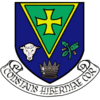Roscommon
|
Roscommon Ros Comáin
|
||
|---|---|---|
| Town | ||
|
||
| Motto: Constans Hiberniae Cor | ||
| Location in Ireland | ||
| Coordinates: 53°38′00″N 8°11′00″W / 53.6333°N 8.1833°WCoordinates: 53°38′00″N 8°11′00″W / 53.6333°N 8.1833°W | ||
| Country | Ireland | |
| Province | Connacht | |
| County | County Roscommon | |
| Area | ||
| • Town | 8 km2 (3 sq mi) | |
| Elevation | 80 m (260 ft) | |
| Population (2006) | ||
| • Urban | 1,677 | |
| • Environs | 3,340 | |
| Irish Grid Reference | M879648 | |
Roscommon (Irish: Ros Comáin, meaning "Saint Coman's wood") is the county town of County Roscommon in Ireland. It is near the meeting of the N60, N61 and N63 roads, putting it roughly in the centre of Ireland.
The name Roscommon is derived from Coman mac Faelchon who built a monastery there in the 5th century. The woods near the monastery became known as Ros Comáin (St. Coman's Wood). This was later anglicised to Roscommon.
Its population at the 2006 census was 5,017 (including rural area). Despite the town itself having a relatively small population, it caters to a large fraction of the population of County Roscommon as Castlerea and Boyle are the only other major towns in the county.
It was the homeland of the Connachta dynasty, and included such kingdoms as Uí Maine, Delbhna Nuadat, Síol Muirdeach, and Moylurg. In addition, it contained areas known as Trícha cét's, Túath and is the homeland of surnames such as Ó Conchobhair (O'Connor), Mac Diarmada (McDermott), Ó Ceallaigh (Kelly), Ó Birn (Beirne, Byrne, Burns), Mac Donnchadha () and Brennan (Mac Branáin and Ó Branáin).
The town is the location of a notable archaeological find in 1945 when a lunula, a gold necklace, and two discs were discovered. Both items are dated to the period 2,300 and 1,800 BC.
...
Wikipedia


